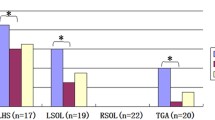Abstract
To reveal the influence of therapeutically induced changes of arterial blood pressure on cerebral circulation, pulsed Doppler measurements of blood velocity in the right internal carotid artery were performed in 23 neonates. A positive correlation between mean arterial blood pressure and time-averaged maximum blood velocity (change more than 0.5%/torr) could be noticed in 16 infants. These infants were supposed to have loss of autoregulation. The main characteristics in this non-autoregulating group were: gestational age <31 weeks, birth weight <1501 g and mean carotid blood velocity <20 cm/s. In accordance with animal experiments we assume that autoregulation does not work below a definite lower limit of brain perfusion, which is reflected by carotid blood velocity in our study. Patients below/equal 1500 g or 30 gestational weeks very often do not exceed this limit and thus do not reach the “range of autoregulation”.
Similar content being viewed by others
Abbreviations
- Vma:
-
time mean of the maximum component of velocity profile (area under the curve divided by length of the cycle)
- Vs:
-
peak systolic velocity
- Vd:
-
end-diastolic velocity
- PI:
-
pulsatility index
- tcpCO2 :
-
transcutaneously measured pCO2
- tcpO2 :
-
transcutaneously measured pO2
References
ahmann PA, Dykes FD, Lazarra A, Holt PJ, Giddens DP, Carrigan TA (1983) Relationship between blood pressure passivity and subependymal/intraventricular haemorrhage as assessed by pulsed Doppler ultrasound. Pediatrics 72:665–669
Batton DG, Hellmann J, Hernandez MJ (1982) Cerebral vascular resistance and blood velocity in newborn puppies by Doppler technique. Pediatr Res 16:1521
Borodzinski K, Filipczynski I, Nowicki A, Powakowski T (1976) Quantitative transcutaneous measurements of blood flow in carotid artery by means of pulsed and continuous wave Doppler methods. Ultrasound Med Biol 2:189–193
Essen C von (1974) Effects of dopamine on the cerebral blood flow in the dog. Acta Neurol Scand 50:39–52
Evans DH (1982) Some aspects of the relationship between instantaneous volumetric blood flow and continuous wave Doppler ultrasound. Ultrasound Med Biol 8:605–623
Friesen RH, Lichtor JL (1981) Indirect measurement of blood pressure in neonates and infants utilizing an automatic noninvasive oscillometric monitor. Anesth Analg 60:742–745
Friis-Hansen B (1985) Perinatal brain injury and cerebral blood flow in newborn infants. Acta Paediatr Scand 4:323–331
Gotoh F, Ebihara SI, Toyoda M, Shinohara Y (1971/72) Role of the autonomic nervous system in autoregulation of human cerebral circulation. Eur Neurol 6:203–207
Greisen G, Johansen K, Ellison PH, Fredriksen PS, Mali J, Friis-Hansen B (1984) Cerebral blood flow in the newborn infant: comparison of Doppler ultrasound and 133Xenon clearance. J Pediatr 104:411–418
Hansen NB, Stonestreet BS, Rosenkrantz TS, Oh W (1983) Validity of Doppler measurements of anterior cerebral artery blood flow velocity: correlation with brain blood flow in piglets. Pediatrics 72:526–531
Harwood-Nash DC (1974) Cerebral vessels in infants and children. In: Newton TH, Potts DG (eds) Radiology of the skull and brain angiography. Mosby, St Louis, Mo, pp 1131–1141
Hilal SK (1974) Cerebral haemodynamics asessed by angiography. In: Newton TH, Potts DG (eds) Radiology of the skull and brain angiography. Mosby, St Louis, Mo, pp 1049–1085
Huber P, Handa J (1967) Effect of contrast material, hypercapnia, hyperventilation, hypertonic glucose and papaverine on the diameter of the cerebral arteries. Angiographic determination in man. Invest Radiol 2:17–32
Jorch G (1987) Transfontanellare Dopplersonografie. Thieme, Stuttgart New York
Jorch G, Menge U (1985) The influence of pCO2 on brain perfusion in neonates — a Doppler-ultrasonographic investigation. Monatsschr Kinderheilkd 133:38–42
Jorch G, Pfannschmidt J, Rabe H (1986) Investigation of cerebral circulation in preterm and term neonates by pulsed Doppler ultrasonography. Basics, technique, reference values. Monatsschr Kinderheilkd 134:804–807
Karickhoff A (1981) Simultaneous blood pressure and anterior cerebral artery flow velocity wave form analysis in the premature infant. Pediatr Res 15:1336
Kier EL (1974) Fetal cerebral arteries: a phylogenetic and ontogenetic study. In: Newton TH, Potts DG (eds) Radiology of the skull and brain angiography. Mosby, St Louis, Mo, pp 1089–1130
Kirkham FJ, Padavachee TS, Parsons S, Seargeant S, House FR, Gosling RG (1986) Transcranial measurement of blood velocities in the basal cerebral arteries using pulsed Doppler ultrasound: velocity as an index of flow. Ultrasound Med Biol 12:15–21
Lassen NA (1968) Brain extracellular pH: the main factor controlling cerebral blood flow. Scand J Clin Lab Invest 22:247–251
Leahy F, Sankaran K, Cates D, McCallum M, Rigatto H (1978) Quantitative non-invasive method of measuring cerebral blood flow in the newborn. Pediatr Res 12:553
Lou HC (1983) Perinatal cerebral ischaemia and developmental neurologic disorders. Acta Paediatr Scand 311:28–31
Lou HC, Lassen NA, Friis-Hansen B (1979) Impaired autoregulation of cerebral blood flow in the distressed newborn infant. J Pediatr 94:118–121
Miyazaki M (1968) Measurement of cerebral blood flow by ultrasonic Doppler technique. Pulsatile variation of vascular diameter of human common carotid artery. Jpn Circ J 32:1003–1009
Pape KE, Wigglesworth JS (1979) Haemorrhage, ischaemia, and the perinatal brain. Clin Dev Med 69/70. Spastics International Medical Publications, London Philadelphia
Perlman JM, McMenamin JB, Volpe JJ (1983) Fluctuating cerebral blood flow velocity in respiratory distress syndrome. N Engl J Med 28:204–209
Raichle ME, Stone HL (1971/72) Cerebral blood flow autoregulation and graded hypercapnia. Eur Neurol 6:1–5
Vannucci RC, Hernandez MJ (1981) Perinatal cerebral blood flow. In: Sinclair JC, Warshaw JB, Bloom RS (eds) Perinatal bain insult. Mead Johnson Symposium on Perinatal and Developmental Medicine. Mead Johnson, USA, pp 17–29
Whitehead MD, Lee BVW, Pagdin TM, Reynolds EOR (1985) Estimation of arterial oxygen and carbon dioxide tensions by a single transcutaneous sensor. Arch Dis Child 60:356–359
Author information
Authors and Affiliations
Rights and permissions
About this article
Cite this article
Jorch, G., Jorch, N. Failure of autoregulation of cerebral blood flow in neonates studied by pulsed Doppler ultrasound of the internal carotid artery. Eur J Pediatr 146, 468–472 (1987). https://doi.org/10.1007/BF00441596
Received:
Accepted:
Issue Date:
DOI: https://doi.org/10.1007/BF00441596




